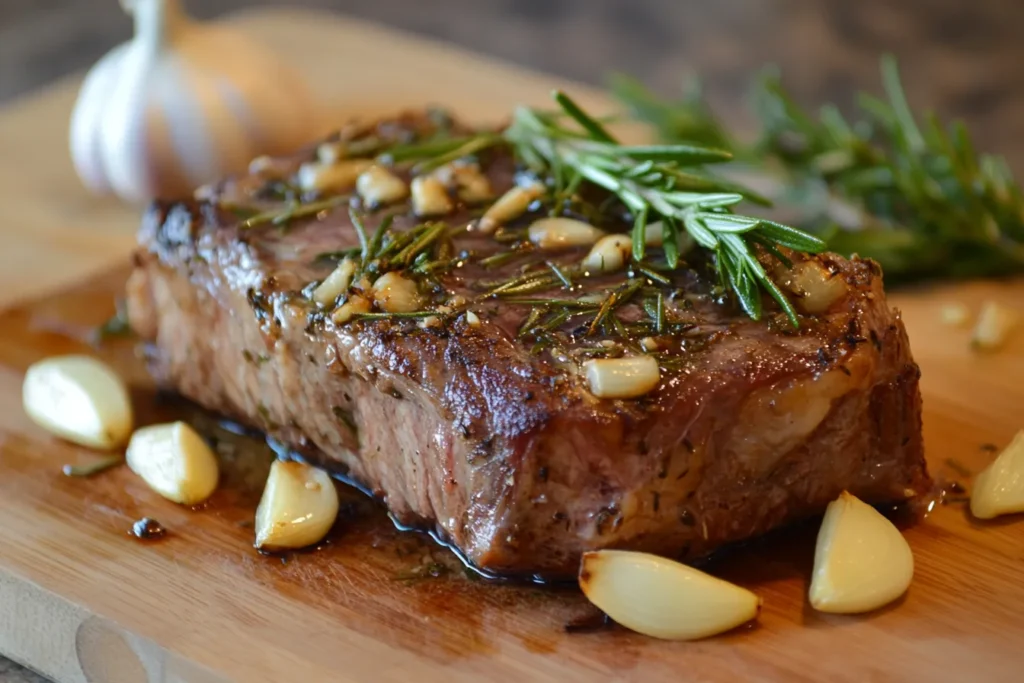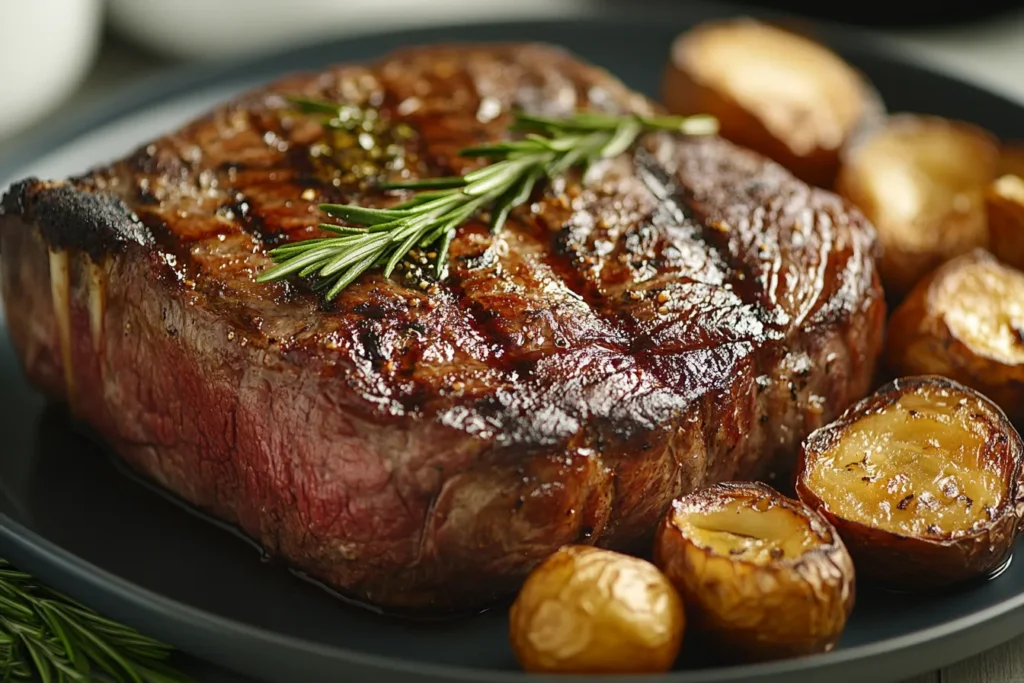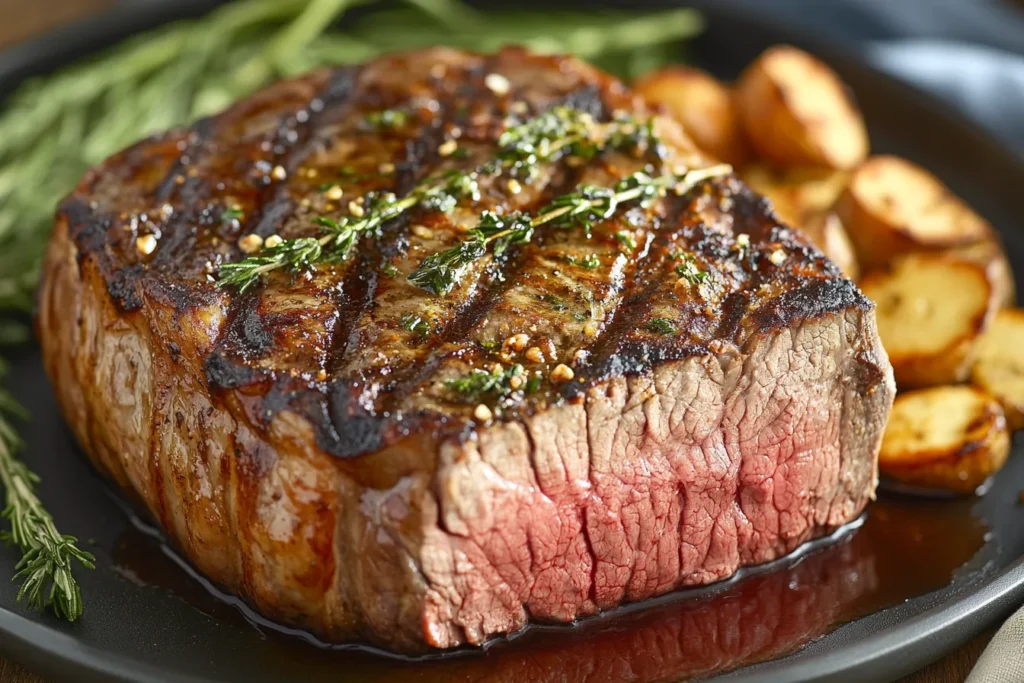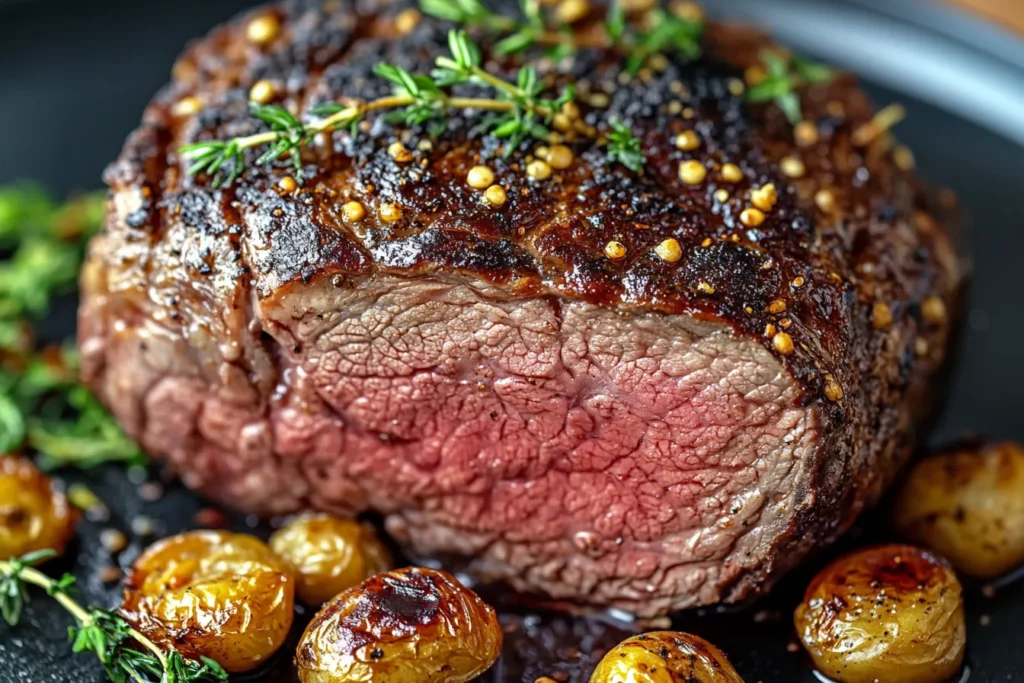Table of Contents
Ribeye roast recipe is a culinary treasure, promising a flavorful and impressive centerpiece for any special occasion. Whether you’re a seasoned chef or a novice cook, understanding the nuances of preparing a perfect ribeye roast can elevate your cooking game. This guide will walk you through the essential steps, providing insights and secrets to guarantee a mouthwatering roast every time.
Understanding the Ribeye Roast
A ribeye roast, also known as a standing rib roast, is a cut of beef taken from the rib section. It’s prized for its rich marbling, which contributes significantly to its flavor and tenderness. Choosing the right roast is the first step toward culinary success (ribeye roast recipe).
Selecting the Perfect Roast
When selecting a ribeye roast, look for abundant marbling throughout the meat. This fat will render during cooking, basting the roast from within and creating a succulent, flavorful result. A good roast should also have a vibrant red color and a firm texture. Consider the size of the roast based on the number of people you plan to serve, typically allowing about one pound per person.
Different Grades of Ribeye
Ribeye roasts are typically graded as Prime, Choice, or Select. Prime is the highest grade, boasting the most marbling. Choice is a good alternative with a decent amount of marbling, and Select is the leanest grade. The grade affects both the price and the final result, so choose according to your budget and preference (ribeye roast recipe).

Essential Equipment and Ingredients
Before diving into the cooking process, ensure you have the necessary equipment and ingredients readily available. This preparation will streamline the process and contribute to a stress-free cooking experience (ribeye roast recipe).
Necessary Equipment
- Roasting Pan: A sturdy roasting pan with a rack is essential to allow air to circulate around the roast, promoting even cooking.
- Meat Thermometer: A reliable meat thermometer is crucial for accurately monitoring the internal temperature of the roast.
- Carving Knife: A sharp carving knife is necessary for slicing the roast into even portions.
- Cutting Board: A large, sturdy cutting board will provide a safe and stable surface for carving.
Key Ingredients
- Ribeye Roast: As discussed, choose a high-quality roast based on your preferences.
- Salt: Kosher salt is recommended for its even distribution and ability to draw out moisture.
- Black Pepper: Freshly ground black pepper adds a robust flavor.
- Garlic: Fresh garlic cloves, minced or crushed, infuse the roast with a savory aroma.
- Rosemary: Fresh rosemary sprigs contribute an earthy, aromatic note.
- Olive Oil: A good-quality olive oil helps to create a flavorful crust.
Step-by-Step Ribeye Roast Recipe
Now, let’s move on to the actual preparation of the ribeye roast. Follow these steps carefully to achieve a perfectly cooked and delicious roast (ribeye roast recipe).
Preparing the Roast
Begin by patting the ribeye roast dry with paper towels. This step is crucial for achieving a good sear. Next, generously season the roast with salt and pepper. Don’t be shy with the seasoning; a good amount of salt is necessary to enhance the flavor of the meat (ribeye roast recipe).
Creating the Herb Crust
In a small bowl, combine minced garlic, chopped rosemary, and olive oil. Mix well to create a fragrant herb paste. Rub the herb paste all over the ribeye roast, ensuring every surface is coated evenly. This herb crust will add depth and complexity to the flavor of the roast.
Searing the Roast (Optional but Recommended)
Searing the ribeye roast before roasting is an optional step that significantly enhances its flavor and appearance. Heat a large skillet or roasting pan over high heat. Add a small amount of olive oil and sear the roast on all sides until it is deeply browned. This searing process creates a Maillard reaction, resulting in a rich, flavorful crust. However, be cautious to avoid burning the herbs during searing (ribeye roast recipe).

Roasting the Ribeye
Preheat your oven to 450°F (232°C). Place the seared or unseared ribeye roast on a roasting rack in a roasting pan. Insert a meat thermometer into the thickest part of the roast, avoiding bone. Roast for 15 minutes, then reduce the oven temperature to 325°F (163°C).
Monitoring the Internal Temperature
Continue roasting the ribeye until it reaches your desired internal temperature. For rare, aim for 120-125°F (49-52°C); for medium-rare, aim for 130-135°F (54-57°C); for medium, aim for 140-145°F (60-63°C). The roasting time will vary depending on the size of the roast and your oven. Generally, it takes about 13-15 minutes per pound for rare and 15-17 minutes per pound for medium-rare (ribeye roast recipe).
Resting the Roast
Once the ribeye reaches your desired internal temperature, remove it from the oven and tent it loosely with foil. Let it rest for at least 20-30 minutes before carving. Resting allows the juices to redistribute throughout the roast, resulting in a more tender and flavorful final product. Skipping this step will result in a dry and less flavorful roast. Therefore, patience is key here.
Carving and Serving
After resting, transfer the ribeye roast to a cutting board. Using a sharp carving knife, slice the roast against the grain into even portions. Serve immediately and enjoy the fruits of your labor. Remember that the internal temperature will continue to rise slightly during resting.
Secret Tips for an Amazing Ribeye Roast
Here are some secret tips to help you achieve an amazing ribeye roast that will impress your guests:
Dry Brining
Dry brining involves salting the roast 1-3 days before cooking. This process allows the salt to penetrate deep into the meat, enhancing its flavor and moisture retention. Simply rub the roast with salt and store it uncovered in the refrigerator until ready to cook (ribeye roast recipe).
Reverse Sear
The reverse sear method involves cooking the roast at a low temperature until it reaches just below your desired internal temperature, then searing it at a high temperature to create a crust. This method results in a more evenly cooked roast with a beautifully browned exterior.
Au Jus
Making an au jus from the pan drippings is a simple way to enhance the flavor of the ribeye roast. After removing the roast from the pan, deglaze the pan with red wine or beef broth, scraping up any browned bits from the bottom. Simmer until the sauce has reduced slightly, then strain and serve with the roast. Furthermore, you can add fresh herbs like thyme and rosemary for extra flavor (ribeye roast recipe).
Bone-In vs. Boneless
A bone-in ribeye roast is often considered to be more flavorful because the bone adds depth to the meat. However, a boneless roast is easier to carve. Ultimately, the choice depends on your personal preference. In addition, consider the cooking time. Bone-in roasts may require slightly longer cooking times (ribeye roast recipe).
Experiment with Seasonings
While salt, pepper, garlic, and rosemary are classic seasonings for a ribeye roast, don’t be afraid to experiment with other herbs and spices. Thyme, oregano, paprika, and even a touch of chili powder can add unique flavors to your roast. Therefore, consider your guests’ preferences when choosing seasonings.

Troubleshooting Common Issues
Even with the best recipes, issues can arise. Here’s how to troubleshoot some common problems:
Roast is Overcooked
If your roast is overcooked, it will be dry and tough. Unfortunately, there’s no way to reverse this, but you can try serving it with a flavorful sauce or gravy to add moisture. Next time, be sure to monitor the internal temperature closely and remove the roast from the oven before it reaches your desired doneness (ribeye roast recipe).
Roast is Undercooked
If your roast is undercooked, you can simply return it to the oven and continue cooking until it reaches the desired internal temperature. Use a meat thermometer to monitor the temperature and prevent overcooking. Remember to let it rest again after further cooking (ribeye roast recipe).
Crust is Not Browning
If your roast’s crust isn’t browning properly, try increasing the oven temperature slightly or searing the roast before roasting. Ensure the roast is dry before searing and that the pan is hot enough. Basting with butter during the final stages of roasting can also promote browning (ribeye roast recipe).
Serving Suggestions
A perfectly cooked ribeye roast deserves equally delicious side dishes. Here are a few suggestions:
- Roasted Vegetables: Roasted potatoes, carrots, and Brussels sprouts complement the richness of the roast.
- Mashed Potatoes: Creamy mashed potatoes are a classic pairing.
- Yorkshire Pudding: Yorkshire pudding adds a touch of elegance.
- Green Beans Almondine: Green beans with toasted almonds offer a fresh contrast.
- Salad: A simple green salad provides a refreshing counterpoint.
FAQ
Is a ribeye roast the same thing as prime rib?
While often used interchangeably, prime rib technically refers to a ribeye roast cooked whole, usually with the bone in. The cut is the same, but prime rib implies a specific preparation method. Therefore, the terms are largely synonymous in everyday usage.
Is ribeye good for roasting?
Absolutely! Ribeye is an excellent cut for roasting due to its generous marbling, which renders during cooking and keeps the meat moist and flavorful. The fat content makes it ideal for high-heat roasting methods. Consequently, it’s a popular choice for special occasions.
How is ribeye best cooked?
Ribeye can be cooked in various ways, but roasting is a favored method for larger cuts. Searing followed by roasting, or reverse searing, are techniques that enhance flavor and texture. The key is to monitor the internal temperature and not overcook. However, individual preferences vary.
Should I sear a ribeye roast before cooking?
Searing is highly recommended but not mandatory. It creates a delicious crust through the Maillard reaction, adding a depth of flavor and appealing texture to the roast. Be careful not to burn the herbs and spices during the searing process. Therefore, monitor the heat closely.

